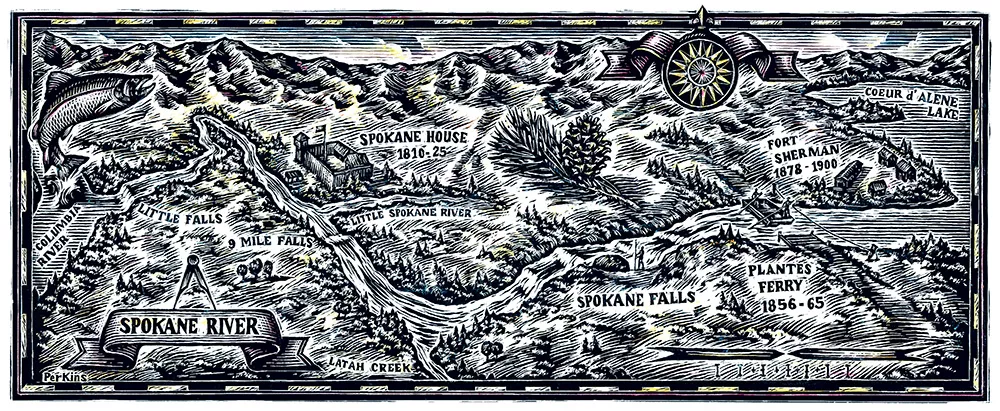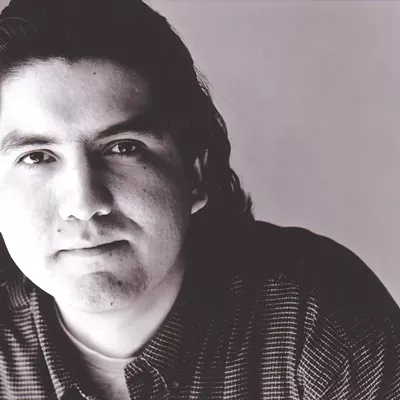It was a warm day, after a series of relatively warm days, about 15,000 years ago. The glaciers of the late Pleistocene Age had reached their stage of maximum advance, with a great mass of ice pushing south from the Purcell Trench to cover what is now Pend Oreille Lake. One lobe of that glacier followed the present course of the Clark Fork River east almost to the Montana line, forming a natural dam that backed up the waters of Glacial Lake Missoula. Similar lobes to the west impounded Glacial Lake Columbia, and although its elevation was considerably lower than that of Lake Missoula, the entire Spokane area lay under water.
On this particular day, the great ice dam on the lower Clark Fork was melting fast, pouring water into its vast glacial lake. When the water level reached about 90 percent of the way to the top of the blocking ice, the dam itself floated upward in exactly the same way that ice cubes float to the top of a drink. Then the dam began to break apart, in a slow powerful burst of icebergs, boulders and grimy brown sediment. Water rushed west, then south, a moving wall that overpowered much of the established landscape in its path. As the Ice Age stuttered to a close, the scene would have been repeated, in varying degrees of violence, several dozen times.
There are still many details to sort out about this basic scenario of the Lake Missoula Floods. Geologists disagree on how many of them took place, and their timing. Similar deluges are being described from Russia and Sweden, so that our local event may no longer even claim the title of the World's Largest Flood. But for now it is by far the best documented, and there is no question that the place we live, and the landscape we see every day, was shaped in large part by those remarkable bursts. All around us lie geologic monuments of timeless importance, and there is a growing movement to preserve them.
The floods dumped hundreds of feet gravel into the areas around Rathdrum Prairie, blocking the former flow lanes of many local bodies of water, so that today the outlets of Hayden, Hauser, Spirit and Twin lakes disappear underground as they reach for the Spokane River. This flood gravel is the heart and substance of the Spokane Aquifer, the single most valuable natural asset of the settled valley where we live. The structure of the aquifer is revealed in places like the Acme Concrete gravel diggings, where a visitor can ponder the tilts, rhythmic lines and overlain sediments left behind by an event of almost incomprehensible scale. Geologists have written scholarly papers about the course of the Lake Missoula Floods by studying the sand pit on Barker Road and the bluffs above Latah Creek.
These Ice Age floods, with their incredible erosive force, laid open the earlier geology of the Spokane River. They exposed Miocene clays full of fossil plants that speak of lush deciduous forest where ponderosa pines grow today.They carved a line between the Columbia Basin basalt flows to the south, with their grand columns and swirling cliff faces, and older Precambrian rocks that slump and curve beyond the north bank of the river. And perhaps most significantly, they set the scene for human settlement by redirecting the Spokane River to the course we see it in today, and carving the falls that form the center of the city. Many of the place names that we use to define the landscape around us, from Upper Falls to the Bowl and Pitcher, from Coyote Rocks to Little Falls, look like they do because of a few warm days long ago.
Tribal Life
As archaeologists push back the dates of human habitation in North America, it seems more and more likely that there may have been people here to watch the last of those floods. In the millenia since, successive waves of inhabitants developed one strand of what anthropologists call Columbia Plateau Culture; they coalesced into the Spokane Tribe. For many generations, three major tribal groups lived along the river, beginning with the Lower Spokanes at its connection with the Columbia River. Their language and lifeways were allied with people to the west such as San Poil, Nespelem and Columbia Salish. Middle and Upper Spokanes had closer ties, both linguistically and culturally, to tribes from the north and east: Kalispel, Pend Oreille, Flathead, Chewelah and Coeur d'Alene. Coeur d'Alene people frequented the upper Spokane River, sharing territory according to season and need and naming sites that extended downstream to Spokane Falls.
These native peoples moved fluidly through a broad landscape, making use of all it had to offer. Lilies, onions, biscuitroot, camas, bitterroot and other native roots were gathered, roasted and stored in cool ice caves, relics of the glacial past, right beside the river. A dozen or more different kinds of berries, carefully dried or mixed into cakes, provided essential vitamins. Ice Age flood gravels lining local streambeds provided ideal spawning grounds for salmon, steelhead and trout; many other tribes traveled long distances to share in their capture. There was one important fishery at Little Falls, and another below Nine Mile Falls that included a weir or fish trap in the Little Spokane River, which the tribes named for its productive steelhead run. Spokane Falls hosted a later six-week season, and smaller tributaries such as Latah and Douglas Creek had their own runs and trapping methods.
Spokane people used their short, beautifully engineered yew wood bows to hunt members of the deer family and all manner of birds. They also walked across the Rocky Mountains to hunt buffalo, carrying trade goods such as camas and dried salmon with them. When European horses arrived around the mid-1700s, the pace of travel and the effectiveness of hunting quickly expanded. But in the early 1780s — at least two decades before any Europeans arrived in person — a devastating epidemic of smallpox drastically reduced the numbers of all Plateau peoples, and the Spokanes shared in this terrible grief.
For some Spokanes, the first actual sighting of the coming wave may well have been two French-Canadian furmen named Le Blanc and La Gasse, who accompanied a traveling band of Kootenais over the Continental Divide in the year 1800, beating Lewis and Clark's expedition to the south of Spokane country by five years. North West Company agent David Thompson sent the voyageurs to the Columbia drainage to explore, and tribal accounts describe a pair of odd-looking white men, one of them bald-headed with a beard, being passed from band to band around that time. Neither was very adept at taking care of himself, but they brought a few trade goods and the message that more white men would follow them in time.
Spokane House
The first written account of Spokane people came from the pen of the same David Thompson, who met a small group while visiting Kalispels on the Pend Oreille River in the fall of 1809. The following spring, Thompson directed his chief scout Jaco Finlay to proceed west and build a trade house among the Spokanes; the site the tribe directed him to was near a Middle Spokane village at the confluence of the Little Spokane River. A clerk named Finan McDonald, although posted at Thompson's Saleesh House in western Montana, may have joined Jaco at the new Spokane House in late summer of 1810. Thompson himself did not arrive to enter the place into the history books until June 1811, after he followed a tribal trail from Cusick south and walked to a site not far from the present boat ramp above the Little Spokane: "here we found Jaco & amp;c with abt 40 Spokane families.”
Over the next 10 months, this Spokane House trading post served as a hub for exploration and transport, with Thompson moving in a great circle around it. Looking for cedar to build canoes, he explored the Spokane River upstream as far as the present Idaho line, but as a man who depended on easy-flowing water, he never gave Spokane Falls any more than a passing nod. When Thompson left Spokane House in the spring of 1812, he transported more than four tons of furs, gathered from all along his trade route, east across the Rocky Mountains. In succeeding years, Pacific Fur, North West and finally Hudson's Bay Company built larger and more well-appointed posts on a site just upstream from Jaco Finlay's original building. Today, the last three company posts are outlined at the Spokane House Interpretive Center.
As far as the economics of the fur trade were concerned, the Spokane House location was never a favorable one. Agents complained of the lack of boat-building cedar trees, big game and workable farmland; of a river made unnavigable by its series of falls; of steep prices demanded by the Spokanes for their invaluable horses. In 1825, Governor George Simpson declared that the post would be moved to Kettle Falls, and within a year, everything of value had been stripped away and moved north. Jaco Finlay, the builder of the original post, became the first European settler in the Spokane country, as he moved into the abandoned buildings with his Spokane wife Teshwentichina and their children. When he died there in May 1828, he was buried beneath the sole bastion of the Hudson's Bay Company post. According to tradition, Teshwentichina placed Finlay's pipe bag and spectacles in the grave beside him. There are still Finlays living in the region who trace their ancestry to old Jaco.
Sharing Fish
For the entire 15-year history of the various Spokane Houses, only one complete journal notebook has survived. It runs from April 1822 through April 1823, and recounts a year of basic news from one Hudson's Bay Company outpost — weather, food acquired, furs traded, jobs the workers were assigned to, tribal movements and the comings and goings of men and goods across the larger Columbia District. The first few months were written by veteran agent Finan McDonald, who then handed the book over to newcomer James Birnie for the bulk of the entries. Chief factor Alexander Kennedy added an annual report, meant for the eyes of company governors in London, that provided a geographic and social setting of the post. Although necessarily limited in perspective — James Birnie in particular seemed to have had no idea of what was going on in the world outside the post — the journal provides a clear perspective on what the furmen and the tribes were doing below Nine Mile Falls for an entire year.
Relationships between the two were mostly cordial, but tensions did flare once in a while. One notable occasion was on August 28, 1822, during the late-summer salmon season, and involved the company fish weir, or "barrier," a project whose construction Finan McDonald had overseen the previous May. The structure, fashioned from poles set in the river to divert ascending fish into eddies, was located on the Little Spokane River near a long-established tribal weir. Over the course of the summer, although many more fish had been taken from the tribal trap than from that of the furmen, there seemed to be plenty to go around.
On this particular morning, as was his habit, Finan McDonald paid a visit to the barrier to count the fish caught in it during the night. According to James Birnie's typically reserved journal entry, "there happened to be some of the indians there spearing the salmon coming up the river. Mr. McD spoke to them but they being in a canoe, put all his threats at defiance." Something about the spearmen's tone touched off Finan McDonald's storied temper, and "...he lost no time in springing into the water & amp; break their canoe. The chief of the place was much displeased and went and break down nine of the palisades of the garden.”
By tearing down the garden fence of the man who had senselessly damaged his canoe, the Spokane chief seems to have hit upon the perfect act of retribution, for this garden was another of McDonald's pet projects — in early spring, he had spent days down in the post cellar sorting through the barrels of the previous year's potato crop for seed sprouts, and in April he had all the women and children out hoeing to prepare the ground. Fortunately for the potatoes, the Spokane chief's brother interceded before the entire fence was destroyed, but both men remained furious. The Spokane House residents were concerned enough to load their single cannon and post a guard at their gate that night — the only time in the entire journal that such actions were deemed necessary. Tempers must have soon cooled down, however, because the very next day Finan McDonald continued preparations for a journey to the mountains with his Pend Oreille wife and children, and James Birnie's journal made no further reference to the offended Spokane chief.
Missionaries
Towards the end of May 1836, the Reverend Samuel Parker was working his way north from Fort Walla Walla to Fort Colvile, scouting the Inland Northwest for possible missionary sites with Marcus Whitman. After traveling through Nez Perce, Palouse and Cayuse country, he encountered his first encampments of Spokane people, and recognized immediately that their Interior Salish language was completely different from anything he had heard before. The people he spoke with seemed receptive to his message, and Parker moved on with growing excitement until he discovered that his guides, unfamiliar with the country, had lost their way.
An early furman named Ross Cox had already published a book recounting how, after being abandoned in this same area, he had been tormented by bears and wolves, rattlesnakes and cactus. It didn't take Parker long to realize that Cox's account was "far more fiction than truth," and when they happened upon a Spokane man who happily guided them to the river with no thought of payment, Parker was sure he had found a paradise on earth. His party soon reached the river crossing just below Nine Mile Falls, where they hollered across the water for the "Indian who keeps a canoe ferry." When a pair of women appeared to relay the news that the ferryman was out hunting, Parker even managed to turn that into a positive: "I never heard voices more expressive of kindness." During the long wait that followed, he watched numerous magpies flit through the open yellow pines and listened to the songs of nesting thrushes and warblers, exactly as we do now in May and early June. After crossing the river, he passed the site of the old Spokane House, now with only one bastion left standing — the burial marker of Jaco Finlay.
On Parker's return trip, he noted that the large valley just above the entrance of the Spokane River to the Columbia "is capable of supporting a much more numerous population than now obtains a subsistence through hunting and fishing." After riding across the lower Spokane on another cheerful Indian ferry, he located a mountain of "rich and very beautiful marble" that, along with the local granites he had seen around the Spokane House site, he deemed handy for building the fine new structures of a bright and urban future. Parker's journey began the missionary era in the Inland Northwest, and when the International Boundary Settlement was signed a decade later, the stage was set for Americans to join the community of Salish, Plains and Eastern Woodlands tribal people and Canadian, European and Hawaiian furmen that had developed in the Spokane country over the previous four decades.
Bridging Cultures
The transition didn't come easily, and the best place to watch the tumultuous events of the nascent Washington Territory in the 1850s was from the front porch of Antoine Plante's home on the Spokane River. Conveniently located at a favorable river crossing that connected roads to the Pend Oreille, Kettle Falls, Coeur d'Alene and the Palouse country, Plante's land is now commemorated as a pleasant park across from Myrtle Point, between Millwood and Trentwood in Spokane Valley.
Antoine Plante was the mixed-blood son of a fur company voyageur who had traveled to the Pacific with Wilson Price Hunt's expedition in 1811, and Antoine himself was running horses for the Hudson's Bay Company as early as 1827. He trapped for the company's 1830 and 1831 Snake River expeditions with various sons of Jaco Finlay, and for the next decade traveled regularly between the Bitterroot, Flathead, Spokane and Colville valleys. Plante married a Pend Oreille woman named Mary Therese in 1834, divorced her, and married a Flathead woman named Mary in 1841. In 1849, he ventured with several fur trade families south to the California Gold Rush. But Antoine had circled back to the Spokane country by 1853, when newly appointed Territorial Governor Isaac Stevens hired him to serve as a guide east from Spokane to Fort Benton on the Missouri.
Upon his return, Plante constructed a large home behind the present park site on the Spokane River, and for years afterward his place served as a reference point for everyone from eastern emigrant parties to military men like Major John Owens of Montana. Antoine continued to hire out as a guide, and in the fall of 1854 escorted Governor Stevens and artist John Mix Stanley from Cataldo Mission to Spokane Falls. The following summer, Stevens brokered a series of peace treaties with Inland Northwest native peoples that failed to satisfy many tribal members: they felt that miners and homesteaders were illegally overrunning their lands.
Governor Stevens was in Montana when he learned that political stability across the new territory was deteriorating. Sending messages ahead to all the interested parties, he crossed the Rocky Mountains in bad weather and made his camp at Antoine Plante's. There, in November, he parlayed with four Colville chiefs, Spokane Garry, Coeur d'Alene emissaries and a selection of furmen, miners and missionaries. The governor's intent was to convince the Salish tribes not to join forces with the Yakamas, who had already chosen the path of war, and in this case he succeeded, although the peace was shaky.
Over the next two years, Major Owens and other travelers continued to visit Plante's farm, but the War of 1858 caught up with Antoine again — the Battle of Spokane Plains took place very near Myrtle Point, and at some point Plante told one visitor that the tribes burned his home and destroyed much of his property. But such matters did not stop Plante from setting up a toll ferry across the river in front of his house, and the 1860-61 session of the territorial legislature granted him a full license to run it. The accompanying price schedule includes rates of $4 for each wagon, $1.50 for a man and a horse, and 15 cents each for each sheep, goat or hog. Both the United States and British Boundary Survey teams of 1858-62 made plenty of use of Plante's Ferry, and Captain John Mullan was impressed enough to designate it as the crossing site for his military road in his report of 1860.
”The ferry at the Spokane is a good one, consisting of a strong cable stretched across the river, and a boat forty feet long; it is kept by a very worthy man, Antoine Plant, a half-breed Flathead Indian, who speaks both French and English; he has a small field under cultivation on the left bank, near the ferry landing, from which he obtains corn, wheat, and vegetables; these, with the salmon found in the river, form an abundant supply for his Indian family. The winters here are generally mild, and stock range the hills and plains the whole season, no provision for forage being made.”
Isaac Kellogg's free bridge across the Spokane River, located just upstream from Myrtle Point, effectively ended Plante's ferry business in 1865. Antoine later lost his land to the railroad right-of-way, and after a legal fight he retired to his old haunts in Montana's Jacco Valley. He died there in 1890, at about 80 years of age.
War
One of the signature events in the history of the Spokane River began to unfold on the morning of September 9, 1858. Colonel George Wright, after successful skirmishes at Four Lakes and Spokane Plains during the previous five days, was relentlessly marching down on a conglomeration of tribal forces that included Spokane, Palouse and Coeur d'Alene men. When soldiers discerned a large cloud of dust on the road ahead, Wright dispatched Major W. N. Grier to investigate, and after a couple of miles of hard riding, Grier overtook the native force's stock of horses. Grier's call for surrender was met with a stern refusal, and the ensuing skirmish resulted in the capture of between 800 and 900 animals. Dragoons and foot soldiers drove the horses to a camp above Liberty Lake, near the present Idaho line, where Wright pondered what course of action to follow. In a letter penned on the spot he said that "I could not hazard the experiment of moving with such a number of animals (many of them very wild)... Should a stampede take place, we might not only lose our captured animals, but many of our own. Under those circumstances, I determined to kill them all, save a few for service in the quartermaster's department... I deeply regretted killing those poor creatures, but a dire necessity drove me to it. This slaughter has been going on since 10 o'clock of yesterday, and will not be completed before this evening."
Surrenders and summary hangings of Indian leaders followed, effectively ending the 1858 War. Colonel Wright well knew what he was about here; in a grim preview of William Tecumseh Sherman's Civil War march through Georgia only six years later, his actions were calculated for maximum effect on the home ground of his enemy. On September 15, Wright wrote
"The chastisement which these Indians have received has been severe but well merited, and absolutely necessary to impress them with our power. For the last eighty miles our route has been marked by slaughter and devastation; 900 horses and a large number of cattle have been killed or appropriated to our own use; many horses, with large quantities of wheat and oats, also many caches of vegetables, kamas, and dried berries, have been destroyed. A blow has been struck which they will never forget."
The colonel could not have guessed how true his words would be. For years afterward, locals referred to the area of "Wright's bone-yard;" even General Sherman himself, on his westward swing of 1877, used the phrase. In 1911, more than a half a century after the event, another writer noted that "the visitor to Spokane Bridge, Washington, may, at any time, have the spot pointed out to him." For many people, the image of those bleached animal bones has not yet gone away.
Fort Sherman
When Civil War generals William Tecumseh Sherman and Philip Sheridan traveled west from Fort Benton in 1877 for an inspection of Northwest military sites, it was a time of more tribal unrest. Settlers were buzzing with news of the Nez Perce War, and the long chase that Chief Joseph was leading the U.S. Calvary on. The mountain portion of the route the generals followed, established by Captain John Mullan only 16 years before, had all but been abandoned, and the troops struggled to cross the Divide. Sherman immediately saw that an open direct route between Missoula and Spokane would have been of great strategic service to General Howard's Nez Perce campaign. He further visualized the supply advantages of a fort situated at the outlet of the Spokane River and Lake Coeur d'Alene, and chose it over several other suggested sites as the place for the new U.S. Army outpost that later assumed his name.
Sherman was one of the nation's most important figures in the 19th century, as he played a pivotal role in the Civil War, the California Gold Rush and was nearly drafted to run for president. Six years after his first visit to Coeur d'Alene, General Sherman returned for another inspection visit to the Lake. "This morning afforded us an opportunity of seeing what manner of place Fort Coeur d'Alene is," Sherman aid-de-camp John Tidball wrote on July 28. "We found it the most delightful site for a military post that the heart can desire... The General was received with the proper salute, and during our stay made a thorough inspection of the place. He had selected this identical spot for the post when, in 1877, he passed through here, traveling over the disused Mullan Road. It was then in the heart of the wilderness; now it has the railroad running near it, and the county around is rapidly settling up."
Over the next few days, as the general and his aid moved downstream through the Spokane Valley to stay in James Glover's fair new city, they gathered their impressions of the place. Like so many other early visitors, it was the river itself, and its crashing falls, that held their attention. "Spokane Falls is an ambitious town of a few year's growth, containing an estimated population of 3000 persons," Sherman's report stated. "The river, first dividing into three channels, makes three separate falls of about 30 feet, and then uniting its transparent green waters, plunges down a sheer descent of 60 feet... The ambition of the place rests upon the falls, a superb water-power, and a superb picture too.”
Further Reading
• The Spokane Aquifer, Washington: Its Geologic Origin and Water-Bearing and Water-Quality Characteristics, by Dee Molenaar
• Glacial Lake Missoula and Its Humungous Floods, by David Alt
• The Spokane Indians: Children of the Sun, by Rubert H. Ruby and John A. Brown
• Sources of the River: Tracking David Thompson across Western North America, by Jack Nisbet
• Exploring Tour Beyond the Rocky Mountains, by Rev. Samuel Parker
• Antoine Plante: Mountain Man, Rancher, Miner, Guide, Hostler and Ferryman, by Jerome Peltier
• Conquest of the Coeur d'Alenes, Spokanes & Palouses, by Benjamin Franklin Manring
• Travel Accounts of General William T. Sherman to Spokan Falls, Washington Territory, in the Summers of 1877 and 1883, by William Tecumseh Sherman and Philip Henry Sheridan
Publication date: 06/05/03























